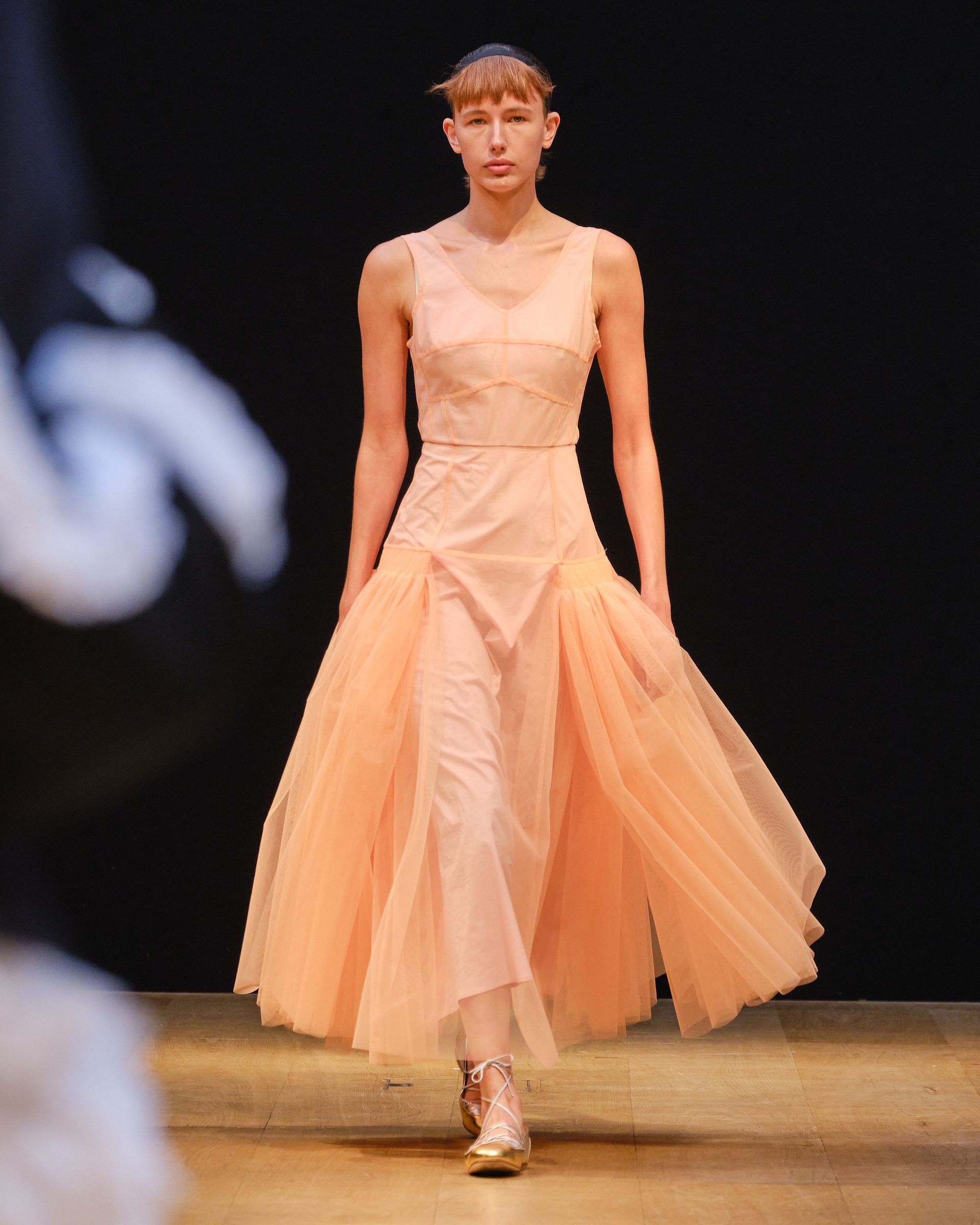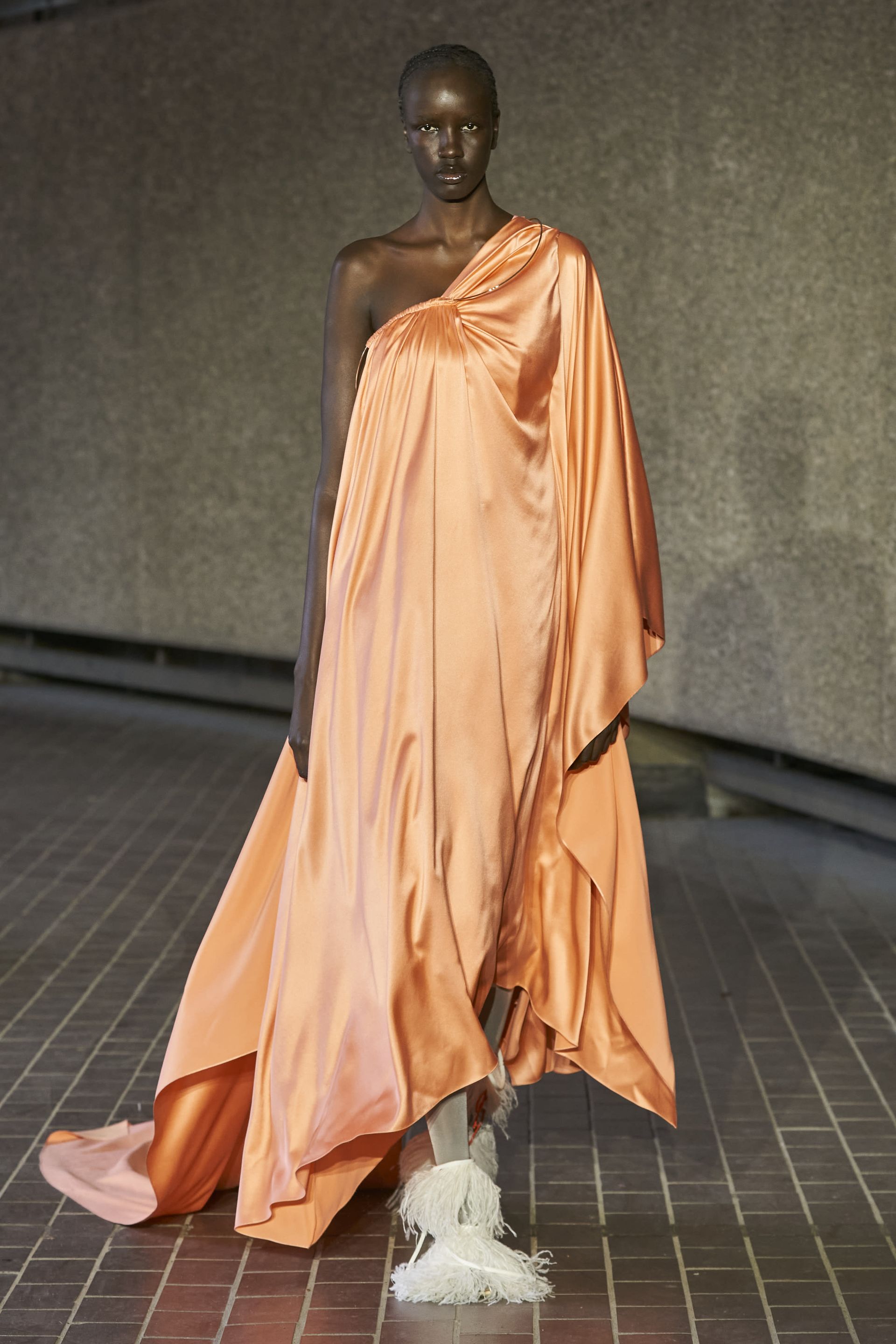London Fashion Week S/S 2024 began with a celebration of 30 years of Newgen – the British Fashion Council’s incubator scheme which supported the careers of many of the designers who now show on the week’s schedule – at the Design Museum. Titled ‘Rebel: 30 Years of London Fashion’ (16 September – 11 February 2024), it captures the rebellious design codes that have defined British fashion for the past three decades.
The eclectic, creative spirit of London’s young designers continues to define the week – among them this season are Aaron Esh (who will make his debut), Chopova Lowena (which will present its sophomore runway show) and this year’s Fashion East line-up, which includes Olly Shinder, Johanna Parv and Standing Ground. Elsewhere, Stefan Cooke, KNWLS, Ahluwalia and Supriya Lele will continue the city’s energetic mood, while stalwarts Simone Rocha, Molly Goddard, Roksanda and Erdem will continue to evolve their distinct offerings.
Perhaps the two most-anticipated shows of the week are JW Anderson – which takes place at the Roundhouse – and Burberry, whereby Daniel Lee will present his sophomore collection in a no-doubt blockbuster show. Jonathan Anderson, meanwhile, will complement his S/S 2024 womenswear outing with the opening of an exhibition at Offer Waterman gallery; titled ‘On Foot’, it will combine both art and fashion for an imagined wander through London.
Here, in our ongoing round-up, is the best of London Fashion Week S/S 2024, as it happens.
The best of London Fashion Week S/S 2024
Molly Goddard

Molly Goddard S/S 2024
(Image credit: Courtesy of Molly Goddard)
Molly Goddard said that this season’s collection began in the costume hire of London’s National Theatre – an extensive archive of garments which have been used in previous productions – where she became fascinated with ‘underskirts and underwear: crinolines, 1950s bras, Victorian christening gowns, Georgian underskirts’. It made for a collection Goddard described as ‘inside out’, the designer taking elements usually hidden – grosgrain zip plackets, hook-and-eye fastenings, the underside of seams – and putting them on show (one tulle dress in particular was left open down the back to reveal its workings beneath). It led to a consideration of craft and making from Goddard: cotton ruffles emerged from simple pin-tuck gowns, cardigans were gently edged with satin, while padded skirts and matching bustier tops recalled quilts or blankets. Elsewhere, faded floral prints, heart-shaped motifs, and simple ribbon fastenings further evoked the domestic – here elevated to the elegant salons of Christie’s auction house, which provided the collection’s backdrop.
JW Anderson

JW Anderson S/S 2024
(Image credit: Courtesy of JW Anderson)
The invitation for this season’s JW Anderson show was a block of modelling clay, a material which was used to create the collection’s opening look: a sculpted hoodie and shorts, warped and exaggerated in proportion as if crudely pressed together by hand. Presented in the sunlit circular hall of Camden’s Roundhouse on Saturday morning and accompanied by an energetic soundtrack which included a Soundcloud mash-up of Ethel Cain’s ‘Crush’ and Cher’s ‘Believe’, it set the tone for a collection which was all about play, seeing Anderson toy with archetypal garments in his typically idiosyncratic style. Much of it was tactile: oversized MA1 bomber jackets were adorned with explosions of feathers which emerged from their interior (‘bursting from the seams’), sculptural circular constructions sat under elongated T-shirt dresses, while a melange of woven elements – from footwear to handbags – appeared throughout. Despite the mood of experimentation, it was a collection nonetheless grounded in reality – it had begun by observing young people on the street – seeing Anderson continue his ongoing journey to distill clothing to its essence, a mood expressed in recent seasons at both his eponymous label and Loewe. ‘I want truth and simplicity,’ he said post-show.
Roksanda

Roksanda S/S 2024
(Image credit: Courtesy of Roksanda)
A temple to brutalism – the vast open-air sculpture court on the Barbican Centre’s top floor – provided the dramatic setting for Roksanda Ilinčić’s latest collection, which nodded towards the Orthodox monasteries of her native Serbia. She did so with a feeling of ceremony: models marched the semi-circular runway crowned with towering headwear recalling the kalimavkion worn by Orthodox clergy, while British soprano Isabelle Peters provided a soaring live soundtrack of Puccini arias. Diaphanous silk gowns, some interwoven with circular metal sculptures, flared ladylike dresses inset with panels of clear perspex, and printed painterly motifs recalling the monastery’s faded frescoes, demonstrated Ilinčić’s astute balance of grandeur and delicacy, which this season felt even more refined. Footwear, a collaboration with Manolo Blahnik, was decorated with fronds of feathers, while a typically luminous palette spanned shades Ilinčić described as elderflower, amaryllis, tangerine, water-chestnut and wisteria.
Chopova Lowena

Chopova Lowena S/S 2024
(Image credit: Courtesy of Chopova Lowena)
Staged in a skatepark under the vast Westway dual carriageway, Emma Chopova and Laura Lowena-Irons returned to a perennial fascination – folklore and traditional ceremonies, and the dress codes which define them. Often, this is derived from Chopova’s Bulgarian heritage – she was born in the United States to Bulgarian parents, and previous seasons have referenced various festivals in the country – though this season, the pair drew inspiration from the British coastal county of Cornwall. Specifically, Helston’s Flora Day festival, which heralds the arrival of summer and sees locals don colourful dress to tell ancient tales of war ‘angels and devils, peace and war, sea and shore, and mermaids and maidens’, as the pair described. As ever, this meant an eclectic amalgam of elements – delicate lily of the valley motifs, clattering hanging charms, naive prints of dragons, demons and angels – brought together across versions of their signature garments (in particular, the pleated kilt and expansive bell-sleeved dresses and shirts). The pair also noted a reference to an altogether more modern myth: ‘falling for a skater boy’ and the dizzy memories of teenage love. As such, nostalgic elements reminiscent of a noughties youth – baggy plaid and cargo pants, graphic tees, bermuda shorts – clashed playfully with the collection’s ancient inspirations. The result? ‘A lovely mess,’ the designers concluded.
Ahluwalia

Ahluwalia S/S 2024
(Image credit: Courtesy of Ahluwalia)
Priya Ahluwalia chose the atrium of The British Library to present her latest collection, which the designer titled ‘Acknowledgements’ – a journey, she said, of ‘creative rediscovery’, which drew her to lesser-known ’makers, doers and thinkers’ from history whose work might not have yet been widely acknowledged by the Western establishment. Among them, Algerian artist Baya Mahieddine who rose to prominence in the 1940s art scene in Paris – her first exhibition was at age 17 in 1947 – and drew the attention of André Breton and Pablo Picasso, both said to have been influenced by her work (others noted in the collection notes included Bollywood actress Madhubala and the American activist Marsha P Johnson). As such, floral motifs featured throughout the collection, in intarsia knits or as a motif across sustainable ISKO-developed denim – a nod, Ahluwalia said, to the expression of ‘giving someone their flowers’ – while other prints and swirling jacquards had a surreal, illusory air ‘challenging the observer to look closer’. Elsewhere, Ahluwalia struck a balance between vintage sportswear – colourful 1970s-style track pants and jackets, patterned sweater vests, football shirts with vivid patchwork patterns – and languid glamour, like a series of fluid cowl-neck dresses in silk viscose, dotted with embellishment and in tones of orange and red which suggested celebration.
Fashion East

Standing Ground S/S 2024
(Image credit: Photography by Chris Yates for Fashion East )
Bloomsbury’s Yeomanry House provided a historic setting for an altogether modern trio of collections from this season’s Fashion East class (or four, if you include the bonus return from A Sai Ta’s label Asai which previously showed as part of the incubator, and here presented a colourful woven collection to close the show).
The highlight was Michael Stewart’s Standing Ground, a designer whose elegantly engineered silhouettes draw their inspiration from the origins and forms of neolithic standing stones, particularly in his native Ireland (‘they’re just beautiful lines, and they, to me evoke a whole a whole world,’ he says). Stewart’s columnar dresses continued to impress this season, while new techniques – like a series of beads intricately stitched into folds of jersey – were designed to recall the discovery of layers of fossils within rocks. There is something about the clarity of Stewart’s design which sets him apart from several of his contemporaries; in just a few seasons he has developed a distinct look, often featuring looping padded elements on otherwise austere jersey gowns. ‘There’s something really natural that happens when I put my mind to jersey,’ he told Wallpaper* prior to the show. ‘I think I’ve developed a handwriting, a language of form.’

Olly Shinder S/S 2024
(Image credit: Photography by Chris Yates for Fashion East )
Both Olly Shinder – who makes his debut with Fashion East this season – and Johanna Parv presented takes on sports- and workwear, albeit in distinct style. Recent Central Saint Martins Shinder – who says he interprets traditionally masculine clothing through a queer lens – captured an after-dark mood with sporty, nightlife-infused pieces which came with a frisson of subversion and sensuality (one garment left a model entirely exposed along the back). There were sheer T-shirts slashed open with zips; dungarees dotted with buttons like studs; workmen’s trousers which appeared dipped in water and dirty from wear, while looping silver body adornments seemed constructed from shower pipes. Completing the mood, Berlin-based photographer Wolfgang Tillmans provided the soundtrack.

Johanna Parv S/S 2024
(Image credit: Photography by Chris Yates for Fashion East )
Parv, meanwhile, continued to explore the everyday needs of women – whether at work or play – reimagining traditional female silhouettes in technical fabrics. In particular, 1950s and 1960s silhouettes were melded with cycling and performance-wear elements – looping straps, toggle fastenings and fabrications with stretch and lightness – for elegance and pragmatism at once.
Stefan Cooke

Stefan Cooke S/S 2024
(Image credit: Courtesy of Stefan Cooke)
Stefan Cooke and Jake Burt used their S/S 2024 show to debut a menswear collection with British leather goods brand Mulberry, seeing the pair transform 27 vintage styles with their distinctive motifs – including the slashed-diamond pattern which is their contemporary take on argyle. The multiplicity of bags – each one entirely unique, some complete with playful adornments like jumbo tassels crafted from upcycled rugby shirts – captured the joyful abandon of the collection, which the designers said was about ‘high-fashion confidence and hardcore craft’. Cue long chequered skirts covered in hundreds of studs, star-adorned knitwear with elongated in-built sashes, or a series of extraordinary sculpted tops crafted from spongy foam (other models carried colourful foam fingers like those brandished at sporting events, the pieces’ inspiration point). Indeed, athletic influences ran throughout the energetic collection: intricately draped tops were cut with wide shoulders for what the designers called ‘a quarterback impact’ and made from a melange of lycra and vintage rugby jerseys. A series of elongated Harrington jackets, looped around the hem with an in-built belt, added a more down-to-earth counterpoint, while brilliant studded or star-covered footwear further demonstrated their ever-growing accessories prowess.
Stay tuned for more from London Fashion Week S/S 2024.
This post was originally published on this site be sure to check out more of their content.





